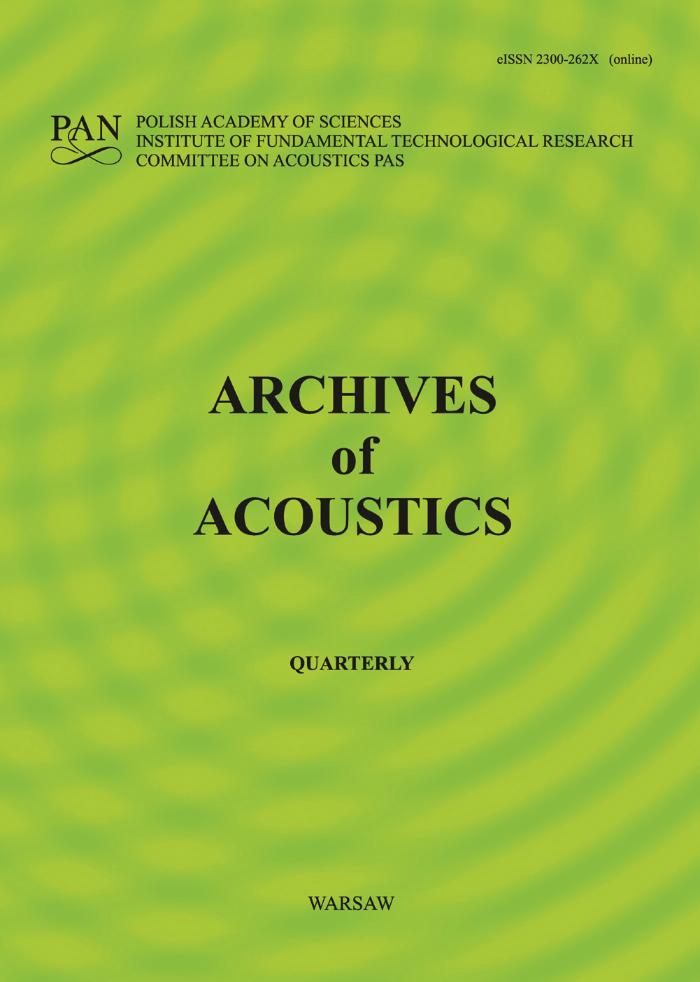Experimental and Numerical Investigations of Acoustic Variations in a Classroom Environment
Abstract
The acoustic behaviour of a classroom is vital for an effective teaching-learning process. The present work aims to experimentally determine the acoustic performance of a typical classroom. The full-scale experiment was conducted at the Seminar Hall, the Department of Applied Mechanics, MNNIT Allahabad, Prayagraj, using a method with limited resource requirements. The Seminar Hall was divided into four planes by threads, and the sound pressure level (SPL) was measured at 30 coordinates in each plane for the specified sound source location. Data were collected from three different sound source locations. The study revealed that the sound source location and frequency significantly influence the sound pressure levels in the classroom, impacting its acoustic performance. The broader implications of interior materials, such as wall material and the position of elements like the teaching board, door, and podium, are highlighted as critical considerations for future classroom acoustic optimization. Furthermore, a numerical model was developed to predict the variation in the SPL with change in the sound source locations and frequencies. The collected data validated with the finite element (FE) model. The verification experiments for the modeling results were performed for each plane. The results of the FE model and experiments were found consistent across all four planes of the seminar hall and the various sound source locations.Keywords:
acoustic measurements, finite element method, room acoustics, sound pressure level, sound source locationReferences
1. Bistafa S.R., Bradley J.S. (2000), Predicting reverberation times in a simulated classroom, The Journal of the Acoustical Society of America, 108(4): 1721–1731, https://doi.org/10.1121/1.1310191.
2. Bradley J.S. (1986), Speech intelligibility studies in classrooms, The Journal of the Acoustical Society of America, 80(3): 846–854, https://doi.org/10.1121/1.393908.
3. Bradley J.S., Reich R.D., Norcross S.G. (1999), On the combined effects of signal-to-noise ratio and room acoustics on speech intelligibility, The Journal of the Acoustical Society of America, 106(4): 1820–1828, https://doi.org/10.1121/1.427932.
4. Bradley J.S., Sato H., Picard M. (2003), On the importance of early reflections for speech in rooms, The Journal of the Acoustical Society of America, 113(6): 3233–3244, https://doi.org/10.1121/1.1570439.
5. Budzyński G. (1986), Theory of the reflective localization of sound sources, Archives of Acoustics, 11(1): 13–24.
6. Gramez A., Boubenider F. (2017), Acoustic comfort evaluation for a conference room: A case study, Applied Acoustics, 118: 39–49, https://doi.org/10.1016/j.apacoust.2016.11.014.
7. Hongisto V., Lindberg M., Lahti A., Veermans M., Alakoivu R., Radun J. (2023), How acoustic refurbishment of a classroom affected pupils and sound levels – A natural experiment, Proceedings of Forum Acusticum, https://doi.org/10.61782/fa.2023.0506.
8. Jerlehag C., Lee P.J., Park S.H., Jones T., Carroll N. (2018), Acoustic environments of patient room in a typical geriatric ward, Applied Acoustics, 133: 186–193, https://doi.org/10.1016/j.apacoust.2017.12.022.
9. Mealings K. (2023a), A scoping review of the effect of classroom acoustic conditions on primary school children’s numeracy performance and listening comprehension, Acoustics Australia, 51(1): 129–158, https://doi.org/10.1007/S40857-022-00284-3/FIGURES/12.
10. Mealings K. (2023b), The effect of classroom acoustic treatment on listening, learning, and well-being: A scoping review, Acoustics Australia, 51(2): 279–291, https://doi.org/10.1007/S40857-023-00291-Y/FIGURES/3.
11. Mealings K., Miles K., Matthews N., Buchholz J.M. (2024), Towards an acoustically accessible campus: A case study of the acoustic conditions of an Australian University, Acoustics Australia, pp. 1–6, https://doi.org/10.1007/s40857-024-00323-1.
12. Mir S.H., Abdou A.A. (2005), Investigation of sound-absorbing material configuration of a smart classroom utilizing computer modeling, Building Acoustics, 12(3): 175–188, https://doi.org/10.1260/135101005774353032.
13. Nabelek A.K., Letowski T.R., Tucker F.M. (1989), Reverberant overlap- and self-masking in consonant identification, The Journal of the Acoustical Society of America, 86(4): 1259–1265, https://doi.org/10.1121/1.398740.
14. Newman R.B., Sabine W.C. (1965), Collected papers on acoustics, Journal of Architectural Education (1947–1974), 20(2): 22, https://doi.org/10.2307/1424115.
15. Nijs L., Rychtarikova M. (2011), Calculating the optimum reverberation time and absorption coefficient for good speech intelligibility in classroom design using U50, Acta Acustica United with Acustica, 97(1): 93–102, https://doi.org/10.3813/AAA.918390.
16. Peng J., Wang C., Jiang P., Lau S.K. (2016), Investigation of Chinese word recognition scores of children in primary school classroom with different speech sound pressure levels, Applied Acoustics, 110: 235–240, https://doi.org/10.1016/j.apacoust.2016.03.026.
17. Rabelo A.T.V., Santos J.N., Oliveira R.C., Magalhaes M. de C. (2014), Effect of classroom acoustics on the speech intelligibility of students, Codas, 26(5): 360–366, https://doi.org/10.1590/2317-1782/20142014026.
18. Reich R., Bradley J. (1998), Optimizing classroom acoustics using computer model studies, Canadian Acoustics – Acoustique Canadienne, 26(4): 15–21, https://jcaa.caa-aca.ca/index.php/jcaa/article/view/1179.
19. Smirnowa J., Ossowski A. (2005), A method for optimising absorptive configurations in classrooms, Acta Acustica United with Acustica, 91(1): 103–109.
20. van Reenen C., Manley D. (2023), Classroom acoustics: Mainstreaming and application of standards, Proceedings of Meetings on Acoustics, 51(1), https://doi.org/10.1121/2.0001745.
21. Vedrtnam A., Pawar S.J. (2018), Experimental and simulation studies on acoustical characterization of laminated safety glass, Glass Technology: European Journal of Glass Science and Technology Part A, 59(2): 58–70, https://doi.org/10.13036/17533546.59.2.008.
22. Vigeant M.C., Wang L.M., Rindel J.H. (2006), Room acoustics computer modeling: Study of the effect of source directivity on auralizations, AEI 2006: Building Integration Solutions – Proceedings of the 2006 Architectural Engineering National Conference, 2006: 22, https://doi.org/10.1061/40798(190)22.
23. Visentin C. (2023), Background noise in classrooms: How it affects performance, EIAS2023 presentation, https://www.acousticbulletin.com/background-noisein-classrooms-how-it-affects-performance-eias-2023/.
24. Visentin C., Prodi N., Cappelletti F., Torresin S., Gasparella A. (2018), Using listening effort assessment in the acoustical design of rooms for speech, Building and Environment, 136: 38–53, https://doi.org/10.1016/j.buildenv.2018.03.020.
25. Vorlander M. (1998), Objective characterization of sound fields in small rooms, [in:] Audio Engineering Society Conference: 15th International Conference: Audio, Acoustics & Small Spaces, 219, https://doi.org/999910121283.
26. Weyna S. (1996), An image of the energetic acoustic field in reduced parallelepiped room models, Acustica, 82(1): 72–81.
27. World Health Organisation (1999), Guidelines for Community Noise, Berglund B., Lindvall T., Schwela D.H. [Eds.].
28. Yang W., Bradley J. S. (2009), Effects of room acoustics on the intelligibility of speech in classrooms for young children, The Journal of the Acoustical Society of America, 125(2): 922–933, https://doi.org/10.1121/1.3058900.
29. Zhang D., Tenpierik M., Bluyssen P.M. (2019), Interaction effect of background sound type and sound pressure level on children of primary schools in the Netherlands, Applied Acoustics, 154: 161–169, https://doi.org/10.1016/j.apacoust.2019.05.007.
2. Bradley J.S. (1986), Speech intelligibility studies in classrooms, The Journal of the Acoustical Society of America, 80(3): 846–854, https://doi.org/10.1121/1.393908.
3. Bradley J.S., Reich R.D., Norcross S.G. (1999), On the combined effects of signal-to-noise ratio and room acoustics on speech intelligibility, The Journal of the Acoustical Society of America, 106(4): 1820–1828, https://doi.org/10.1121/1.427932.
4. Bradley J.S., Sato H., Picard M. (2003), On the importance of early reflections for speech in rooms, The Journal of the Acoustical Society of America, 113(6): 3233–3244, https://doi.org/10.1121/1.1570439.
5. Budzyński G. (1986), Theory of the reflective localization of sound sources, Archives of Acoustics, 11(1): 13–24.
6. Gramez A., Boubenider F. (2017), Acoustic comfort evaluation for a conference room: A case study, Applied Acoustics, 118: 39–49, https://doi.org/10.1016/j.apacoust.2016.11.014.
7. Hongisto V., Lindberg M., Lahti A., Veermans M., Alakoivu R., Radun J. (2023), How acoustic refurbishment of a classroom affected pupils and sound levels – A natural experiment, Proceedings of Forum Acusticum, https://doi.org/10.61782/fa.2023.0506.
8. Jerlehag C., Lee P.J., Park S.H., Jones T., Carroll N. (2018), Acoustic environments of patient room in a typical geriatric ward, Applied Acoustics, 133: 186–193, https://doi.org/10.1016/j.apacoust.2017.12.022.
9. Mealings K. (2023a), A scoping review of the effect of classroom acoustic conditions on primary school children’s numeracy performance and listening comprehension, Acoustics Australia, 51(1): 129–158, https://doi.org/10.1007/S40857-022-00284-3/FIGURES/12.
10. Mealings K. (2023b), The effect of classroom acoustic treatment on listening, learning, and well-being: A scoping review, Acoustics Australia, 51(2): 279–291, https://doi.org/10.1007/S40857-023-00291-Y/FIGURES/3.
11. Mealings K., Miles K., Matthews N., Buchholz J.M. (2024), Towards an acoustically accessible campus: A case study of the acoustic conditions of an Australian University, Acoustics Australia, pp. 1–6, https://doi.org/10.1007/s40857-024-00323-1.
12. Mir S.H., Abdou A.A. (2005), Investigation of sound-absorbing material configuration of a smart classroom utilizing computer modeling, Building Acoustics, 12(3): 175–188, https://doi.org/10.1260/135101005774353032.
13. Nabelek A.K., Letowski T.R., Tucker F.M. (1989), Reverberant overlap- and self-masking in consonant identification, The Journal of the Acoustical Society of America, 86(4): 1259–1265, https://doi.org/10.1121/1.398740.
14. Newman R.B., Sabine W.C. (1965), Collected papers on acoustics, Journal of Architectural Education (1947–1974), 20(2): 22, https://doi.org/10.2307/1424115.
15. Nijs L., Rychtarikova M. (2011), Calculating the optimum reverberation time and absorption coefficient for good speech intelligibility in classroom design using U50, Acta Acustica United with Acustica, 97(1): 93–102, https://doi.org/10.3813/AAA.918390.
16. Peng J., Wang C., Jiang P., Lau S.K. (2016), Investigation of Chinese word recognition scores of children in primary school classroom with different speech sound pressure levels, Applied Acoustics, 110: 235–240, https://doi.org/10.1016/j.apacoust.2016.03.026.
17. Rabelo A.T.V., Santos J.N., Oliveira R.C., Magalhaes M. de C. (2014), Effect of classroom acoustics on the speech intelligibility of students, Codas, 26(5): 360–366, https://doi.org/10.1590/2317-1782/20142014026.
18. Reich R., Bradley J. (1998), Optimizing classroom acoustics using computer model studies, Canadian Acoustics – Acoustique Canadienne, 26(4): 15–21, https://jcaa.caa-aca.ca/index.php/jcaa/article/view/1179.
19. Smirnowa J., Ossowski A. (2005), A method for optimising absorptive configurations in classrooms, Acta Acustica United with Acustica, 91(1): 103–109.
20. van Reenen C., Manley D. (2023), Classroom acoustics: Mainstreaming and application of standards, Proceedings of Meetings on Acoustics, 51(1), https://doi.org/10.1121/2.0001745.
21. Vedrtnam A., Pawar S.J. (2018), Experimental and simulation studies on acoustical characterization of laminated safety glass, Glass Technology: European Journal of Glass Science and Technology Part A, 59(2): 58–70, https://doi.org/10.13036/17533546.59.2.008.
22. Vigeant M.C., Wang L.M., Rindel J.H. (2006), Room acoustics computer modeling: Study of the effect of source directivity on auralizations, AEI 2006: Building Integration Solutions – Proceedings of the 2006 Architectural Engineering National Conference, 2006: 22, https://doi.org/10.1061/40798(190)22.
23. Visentin C. (2023), Background noise in classrooms: How it affects performance, EIAS2023 presentation, https://www.acousticbulletin.com/background-noisein-classrooms-how-it-affects-performance-eias-2023/.
24. Visentin C., Prodi N., Cappelletti F., Torresin S., Gasparella A. (2018), Using listening effort assessment in the acoustical design of rooms for speech, Building and Environment, 136: 38–53, https://doi.org/10.1016/j.buildenv.2018.03.020.
25. Vorlander M. (1998), Objective characterization of sound fields in small rooms, [in:] Audio Engineering Society Conference: 15th International Conference: Audio, Acoustics & Small Spaces, 219, https://doi.org/999910121283.
26. Weyna S. (1996), An image of the energetic acoustic field in reduced parallelepiped room models, Acustica, 82(1): 72–81.
27. World Health Organisation (1999), Guidelines for Community Noise, Berglund B., Lindvall T., Schwela D.H. [Eds.].
28. Yang W., Bradley J. S. (2009), Effects of room acoustics on the intelligibility of speech in classrooms for young children, The Journal of the Acoustical Society of America, 125(2): 922–933, https://doi.org/10.1121/1.3058900.
29. Zhang D., Tenpierik M., Bluyssen P.M. (2019), Interaction effect of background sound type and sound pressure level on children of primary schools in the Netherlands, Applied Acoustics, 154: 161–169, https://doi.org/10.1016/j.apacoust.2019.05.007.







